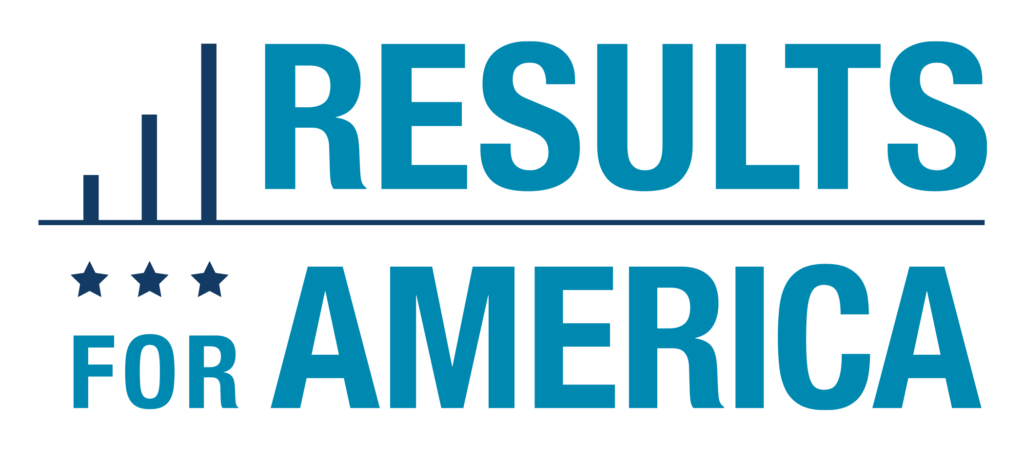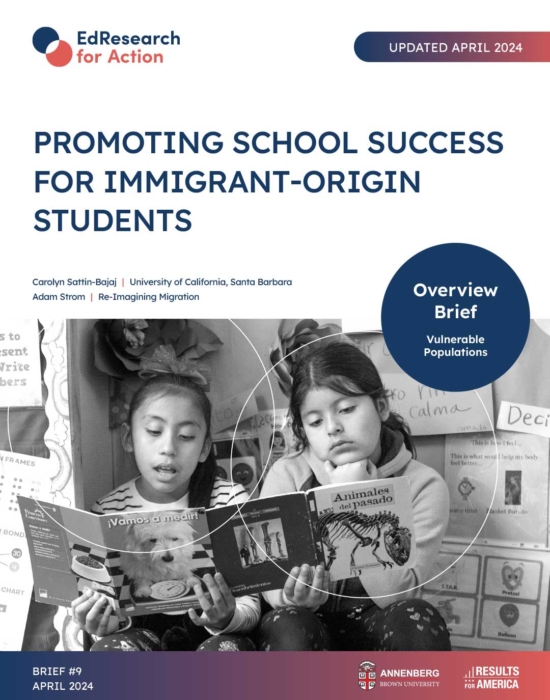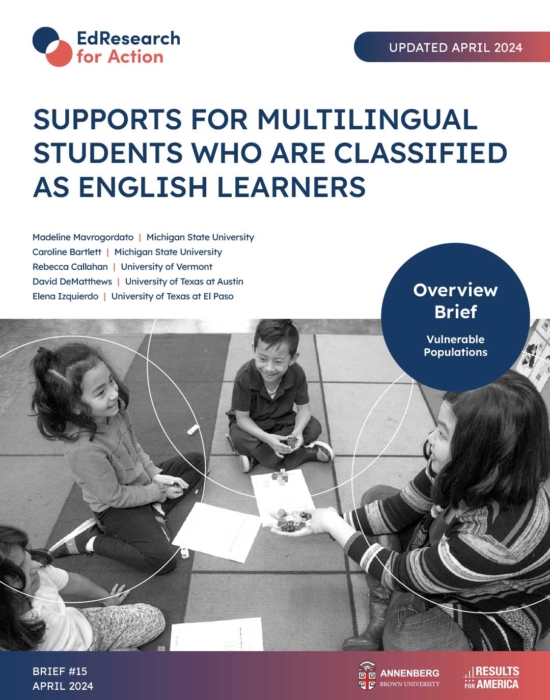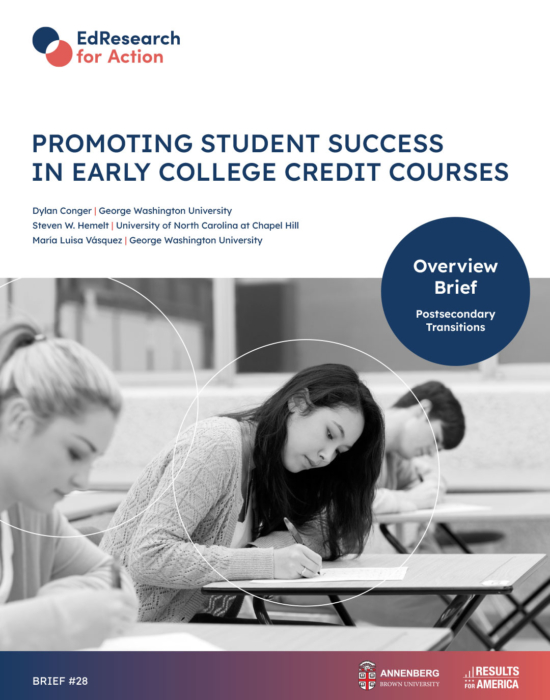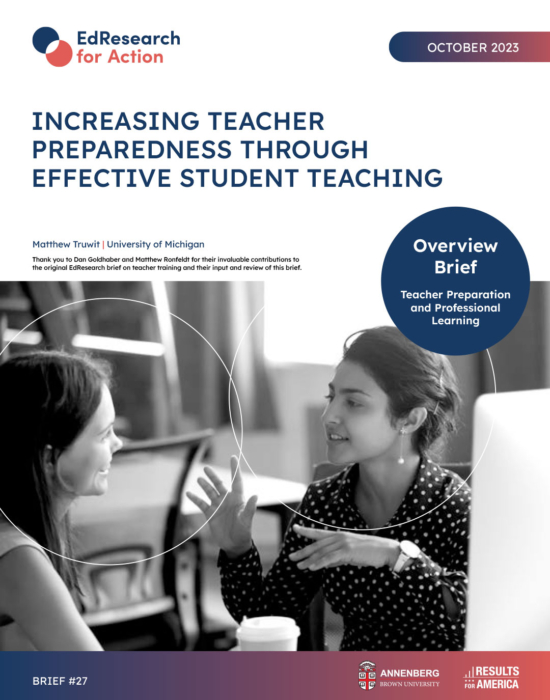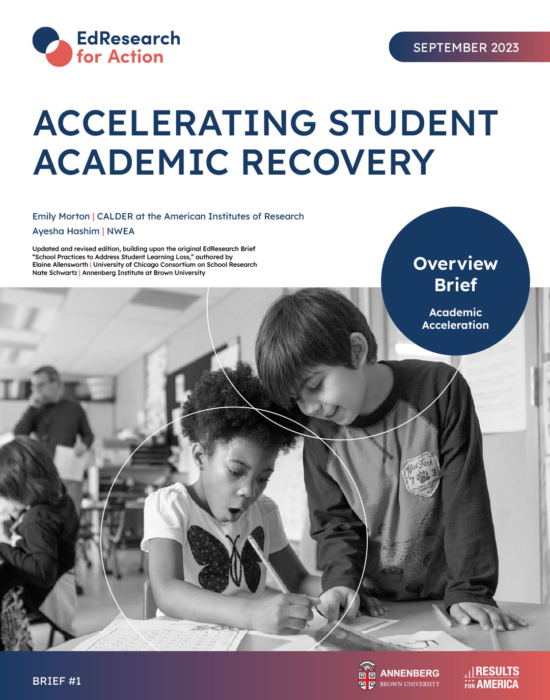INCREASING TEACHER PREPAREDNESS THROUGH EFFECTIVE STUDENT TEACHING
The EdResearch for Action Overview Series summarizes the research on key topics to provide K-12 education decision makers and advocates with an evidence base to ground discussions about how to best serve students. Authors – leading experts from across the field of education research – are charged with highlighting key findings from research that provide concrete, strategic insight on persistent challenges sourced from district and state leaders.
Matthew Truwit | University of Michigan
Thank you to Dan Goldhaber (CALDER at the American Institutes of Research) and Matthew Ronfeldt (University of Michigan) for their invaluable contributions to the original EdResearch brief on teacher training and their input and review of this brief.
October 2023 | Brief No. 27
Central Question
What does research tell us about how student teaching experiences can best prepare new teachers?
Key Insights
Breaking Down the Issue
- State regulations often only provide minimum requirements for student teaching, resulting in traditional experiences that vary widely in length and quality. Nontraditional pathways to teaching have more recently introduced alternative student teaching approaches.
- A lack of clear, rigorous criteria for mentor teacher selection hinders the identification and recruitment of effective mentors.
- Mentors are often not well compensated or trained and are not provided time outside the regular demands of the role, which can make teachers reluctant to serve.
Evidence-Based Practices
- Intentionally recruiting and incentivizing effective teachers to serve as mentors improves candidates’ preparedness to teach.
- In-person training sessions led by expert coaches can improve the coaching practices of mentor teachers.
- Frequent feedback from university supervisors and mentors has been shown to improve teacher effectiveness.
- When teacher candidates are placed in schools with collaborative environments, effective faculty, and low turnover, they have better learning experiences and they practice more effective instruction.
- Teachers who experience high alignment between their student teaching placements and current job are more effective and more likely to stay in the profession.
Practices to Avoid
- The duration of candidates’ student teaching alone does not seem to impact their initial instructional effectiveness.
- Recruiting mentors based on years of experience alone is not enough to ensure that they will be effective mentors.
- Relying heavily on available teacher effectiveness metrics, such as observation ratings, for selecting high-quality mentors may provide an incomplete picture of effectiveness and can introduce bias against teachers of color.
- Although having a more instructionally effective mentor appears to cause candidates to become better teachers, it does not appear to alter if, where, or for how long candidates are employed.
- Simply paying mentors a small stipend may not be enough to alter who chooses to serve and how.
- What we know about the settings that are conducive to candidates’ development is in some ways at odds with the goal of an equitably distributed teacher workforce.
Breaking Down the Issue
What is student teaching and why does it matter?
The nation’s teacher workforce is “greener than ever,” with more than double the proportion of first-year educators compared to just 30 years prior. These novice educators tend to be less effective and have higher attrition rates than their more experienced colleagues, especially in schools where the majority of students are students of color or in poverty—schools where these teachers work at disproportionate and increasing rates. In 2012, 53% of new teachers taught in schools serving a majority of economically disadvantaged students; 44% were in schools with a majority of students of color (compared to just 20% and 24% in 1988).
As we increasingly rely on new teachers, anticipate staffing shortages, and see increased expectations for student success in an accountability-focused education system, teacher preparation programs face mounting pressure to ensure that graduates are well prepared for the workforce.
Surveys of new teachers show that the student teaching experience is the most important part of their preparation. This experience allows teacher candidates to apply their coursework knowledge in real classroom contexts under the guidance of mentor (cooperating) teachers. During this time, teacher candidates progressively assume greater classroom responsibilities while receiving support from both mentor teachers and university supervisors (or field instructors). These mentors typically observe, evaluate, and provide feedback to candidates while modeling instruction to facilitate their development as teachers.
Effective student teaching experiences can address critical issues in the teacher workforce in the following ways:
- Increasing the effectiveness of novice teachers. Student teaching allows teacher candidates to apply theory to practice, develop classroom management skills, and refine instructional strategies under the guidance of skilled mentors, helping them become more effective educators for potentially longer careers.
- Addressing teacher shortages and district needs. Where candidates complete their student teaching is related to where they seek employment; schools and districts that host and prioritize effective student teaching experiences may become more attractive to prospective educators. Strategically placing student teachers in schools and districts can also serve as a lever for equity.
- Enhancing existing teacher workforce quality. Mentoring student teachers can bolster the instructional quality of the existing teacher workforce, providing opportunities for veteran educators to engage in professional growth and fostering a culture of continuous improvement.
An effective mentor is the most important component of the teacher preparation experience, affecting teacher candidates’ readiness and effectiveness in their initial years. Many large-scale correlational studies conducted in multiple geographic contexts and using different measures and methods, have found that teacher candidates with more instructionally effective mentors (measured by value added and observation ratings) are more effective early career teachers. The benefit—likely due to the higher quality of both the modeling and coaching these mentors provide—is roughly equivalent to having an additional year of experience.
What are the challenges and barriers to effective student teaching experiences and mentorship?
State regulations often only provide minimum requirements for student teaching in traditional programs, resulting in experiences that vary widely in length and quality. Nontraditional pathways to teaching have more recently introduced alternative student teaching approaches.
- Typical student teaching experiences last one semester (16 weeks), but many range in length from 8 to over 30 weeks.
- Only about half of all states (27) require student teaching to last at least 10 weeks; even fewer explicitly mandate that it be “full-time.”
- The frequency and quality of support provided to teacher candidates by mentor teachers and field instructors vary significantly and are often inadequate, due to competing demands on the mentor teacher. Consequently, many teacher candidates report that student teaching often feels disconnected from what they have learned throughout their programs.
- Alternative (or job-embedded) programs, which produced about 23% of new teachers in 2019 (nearly 35,000), typically involve a much shorter period of student teaching—or even none at all—before candidates become teachers of record.
- Teacher residency programs comprise a much smaller but quickly growing pathway and collectively enroll only about 2,200 candidates each year. These programs prioritize even more intensive clinical experiences in the shape of a full year of co-teaching alongside an expert mentor.
A lack of clear, rigorous criteria for mentor teacher selection hinders the identification and recruitment of effective mentors.
- Most programs do not set clear, rigorous criteria for the instructional and/or mentoring effectiveness of mentor teachers beyond a low threshold for minimum years of experience.
- Instead, social networks appear to play an important role in determining who becomes a mentor teacher as well as which teacher candidates these mentors are assigned. Some of the strongest predictors for where and with whom student teaching occurs include the geographic proximity of the site (usually within 25 miles of the teacher education program) and whether a potential mentor or their principal attended the same program as the candidate.
- Information asymmetry and competing demands among programs and districts make the placement process feel like something of a mystery, but school and district administrators are the ones who typically determine how the exact match gets made, often in ways that produce a sense of powerlessness among programs.
- A study in Washington State found that the number of effective teachers available to serve as mentors is two to four times the number currently serving, with teacher effectiveness assessed through value-added scores reflecting their impact on student learning.
Mentors are often not well compensated or trained and are not provided time outside the regular demands of the role, which can make teachers reluctant to serve.
- Mentor teachers are usually not compensated for their time, or they are paid very little. Programs only provide teachers with an average of $200 to $250 for their service as mentors, despite the fact that a mentor “may well spend more time with the student teacher than the student teacher spent in all his/her professional education courses combined.”
- Mentors, especially in traditional pathways, do not commonly receive any professional development on how to support the teacher candidates they are assigned, leaving them feeling ill-equipped to guide and support their mentees.
- Adding mentoring responsibilities on top of existing teaching duties can further strain effective teachers’ time and energy resources.
In the current climate of accountability, highly effective teachers may hesitate to serve as mentors due to concerns that dedicating instructional time to coaching teacher candidates could have a negative impact on their own value-added scores, despite consistent evidenceacross studies that it will not. (It may, in fact, provide a boost).
Evidence-Based Practices
What does the research say about practices that contribute to effective student teaching experiences?
Intentionally recruiting and incentivizing effective teachers to serve as mentors improves candidates’ preparedness to teach.
- In one randomized control trial, districts provided with recommendation lists—generated using administrative data on teachers’ instructional performance and years of experience—were able to recruit mentor teachers who were more effective (by about 0.20 standard deviations) and more experienced (by about 5 years). The teacher candidates placed in the districts that received these lists reported feeling significantly better prepared to teach. These results suggest that the most instructionally effective and experienced teachers were not already being asked to be mentor teachers and illustrate a low-cost policy lever for raising the overall effectiveness of the pool of mentor teachers that is easily implemented at scale.
- A similar study that randomly assigned candidates to more or less instructionally effective mentor teachers (and to schools with better or worse working conditions) found that the instructional effectiveness of candidates in the higher quality placements grew at significantly faster rates.
- When teacher candidates report receiving more frequent and higher quality coaching from their mentors, they feel significantly more prepared for the classroom, extend their plans to teach (by about a year), and are more instructionally effective in their first years.
In-person training sessions led by expert coaches can improve the coaching practices of mentor teachers.
- Experimental evidence has shown that professional development—especially models that involve in-person training sessions led by expert coaches—can alter the types, quality, and frequency of coaching practices used by clinical mentors. For example, a randomized controlled trial in Tennessee illustrated that two days of professional development focused on the instructional practice of questioning led to a significant increase in the frequency of coaching provided by mentors, especially in the pedagogical areas targeted during training.
Frequent feedback from university supervisors and mentors has been shown to improve teacher effectiveness.
- Programs that handpick experienced mentor teachers and ensure that university supervisors provide candidates with frequent feedback appear to produce teachers with the equivalent of their first year of teaching experience.
When teacher candidates are placed in schools with collaborative environments, effective faculty, and low turnover, they have better learning experiences and they practice more effective instruction.
- New teachers from various states have demonstrated higher instructional effectiveness—equivalent to 6 months to a year of teaching experience—and have stayed in the profession longer after student teaching in schools that prioritized teacher collaboration, employed a more instructionally effective faculty, and had lower teacher turnover rates. Assuming that student teaching operates similarly to in-service settings, these relationships may be attributable to the fact that schools with more positive working environments are sustainably organized for teacher learning.
- These experiences may especially promote development among initially less effective student teachers, as they are particularly advantageous for candidates with lower GPAs.
- Across settings, studies, and measures, evidence is mixed as to whether learning to teach in schools serving more students of color and more lower-income students results in higher levels of early career instructional effectiveness; moreover, student demographics during student teaching are consistently unrelated to teacher retention.
Teachers who experience high alignment between their student teaching placements and current job are more effective and more likely to stay in the profession.
- Teachers who start their careers teaching the same grade and in the same school level where they completed their student teaching tend to be more effective and have higher retention rates. However, grade-level match occurs for only a quarter of first-year teachers. Additionally, teachers perform better and are less likely to leave the profession when their student teaching demographics closely align with those of their employment settings.
Teacher candidates who were hired into the specific school in which they student taught were rated as substantially more instructionally effective—0.15 points higher on a 4-point scale— than teachers who were not. In another setting, however, new teachers who found employment in their placement schools had value-added scores comparable to their peers working in different schools.
Practices to Avoid
What strategies have been proven ineffective?
The duration of candidates’ student teaching alone does not seem to impact their initial instructional effectiveness.
- After accounting for other measures of the quality of preparation they received, whether or not candidates had a student-teaching experience was not consistently predictive of their own students’ math or English language arts test performance.
- Across studies, candidates with longer student teaching experiences feel more prepared to teach; they have not, however, consistently demonstrated early-career instructional effectiveness higher than their peers with shorter clinical placements.
- Early career teachers who completed alternative programs like Teach for America have been shown to outperform or perform comparably to novice peers, though these comparisons are less favorable when more strictly controlling for teachers’ certifications and classroom characteristics.
Recruiting mentors based on years of experience alone is not enough to ensure that they will be effective mentors.
- Despite often being the only characteristic explicitly written into state regulations, mentors’ years of teaching experience are unrelated to and even negatively predictive of candidates’ feelings of preparedness or instructional effectiveness.
Relying heavily on available teacher effectiveness metrics, such as observation ratings, for selecting high-quality mentors may provide an incomplete picture of effectiveness and can introduce bias against teachers of color.
- Given evidence that traditional measures of instructional effectiveness, like observation ratings, tend to favor White teachers in more privileged settings, overemphasizing these metrics may disproportionately exclude teachers of color in majority-minority schools from serving as mentors.
- Although the two skill sets are related, one estimate suggests that less than 60% of effective teachers of children will make good coaches of adults. While effectiveness with children is traditionally more easily identified through observational or value-added measures, no common administrative metrics exist for measuring effectiveness with adults.
Although having a more instructionally effective mentor appears to cause candidates to become better teachers, it does not appear to alter if, where, or for how long candidates are employed.
- Studies find no association between mentors’ value added and candidates’ likelihoods of finding employment or with their patterns of retention.
- The channels through which the student teaching experience affects candidates’ instructional effectiveness may be at least partially distinct from those through which it influences employment decisions.
Simply paying mentors a small stipend may not be enough to alter who chooses to serve and how.
- In one district, effective teachers were relatively unresponsive to a $500 incentive to serve as a mentor teacher; in another state, a professional development initiative for mentors accompanied by financial compensation ($500), among other incentives, was met with modest (50%) compliance.
- Back-of-the-envelope calculations for the value of mentors’ contributions using the salary differential of a year of additional experience—the expected increase in the effectiveness of their candidates—range between $1,100 and $1,800 as a national average.
- At the same time, teachers report barriers to serving as mentors around time and resources that increased compensation alone may not resolve.
What we know about the settings that are conducive to candidates’ development is in some ways at odds with the goal of an equitably distributed teacher workforce.
- Prioritizing placement of candidates in settings with better working conditions (indicated by higher student growth and/or lower teacher turnover) is beneficial to their instructional effectiveness. However, this approach may only further supply the highest-performing schools with the most promising and initially effective teachers.
This EdResearch for Action Project brief is a collaboration among:


